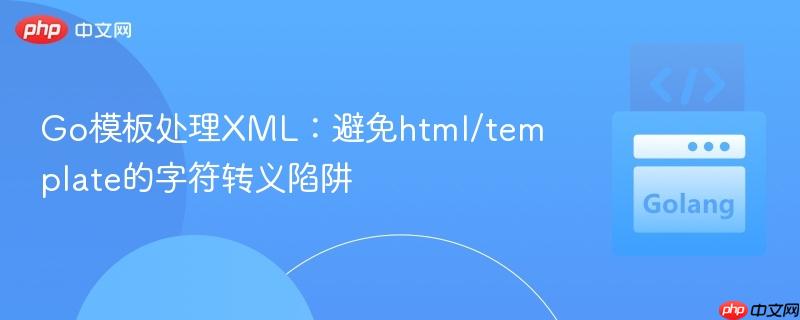
在go语言中,使用`html/template`处理xml文件时,可能会遇到xml声明(如``)中的尖括号被错误转义为`
html/template包是Go语言标准库中用于生成HTML输出的强大工具。它的核心设计理念是防止跨站脚本(XSS)攻击,因此在渲染模板时,会对HTML中的特殊字符(如、&、"等)进行自动转义,将其转换为对应的HTML实体,以确保输出内容的安全性。
然而,这种安全机制在处理非HTML文本(例如XML文件)时,反而可能导致不期望的结果。当尝试使用html/template.ParseFiles()加载一个XML文件作为模板时,XML声明中的尖括号
考虑以下XML模板文件 xml/in2.xml:
<?xml version="1.0" encoding="utf-8"?>
<in2>
<unique>{{.}}</unique>
<moe>100%</moe>
</in2>以及使用html/template进行处理的Go代码:
立即学习“前端免费学习笔记(深入)”;
package main
import (
"fmt"
"html/template" // 注意这里使用了 html/template
"net/http"
)
func in2Handler(w http.ResponseWriter, r *http.Request) {
w.Header().Set("Content-Type", "text/xml")
t, err := template.ParseFiles("xml/in2.xml") // 加载XML模板
if err != nil {
http.Error(w, fmt.Sprintf("Error parsing template: %v", err), http.StatusInternalServerError)
return
}
uniqueValue := "something"
err = t.Execute(w, uniqueValue) // 执行模板
if err != nil {
http.Error(w, fmt.Sprintf("Error executing template: %v", err), http.StatusInternalServerError)
}
}
func main() {
http.HandleFunc("/in2", in2Handler)
fmt.Println("Server listening on :8080")
http.ListenAndServe(":8080", nil)
}运行上述代码并通过HTTP请求访问/in2时,你可能会观察到类似以下的输出:
<?xml version="1.0" encoding="utf-8"?>
<in2>
<unique>something</unique>
<moe>100%</moe>
</in2>显然,XML声明的尖括号被转义,导致输出不再是一个有效的XML文档。
解决html/template对XML进行不当转义的最直接方法是改用text/template包。text/template包是Go语言中用于处理通用文本模板的工具,它不会执行任何HTML特定的安全转义,因此可以原样输出模板中的所有内容,包括XML声明中的尖括号。
以下是使用text/template修改后的代码示例:
package main
import (
"fmt"
"net/http"
"text/template" // 关键:这里改用 text/template
)
func in2Handler(w http.ResponseWriter, r *http.Request) {
w.Header().Set("Content-Type", "text/xml")
t, err := template.ParseFiles("xml/in2.xml") // 加载XML模板
if err != nil {
http.Error(w, fmt.Sprintf("Error parsing template: %v", err), http.StatusInternalServerError)
return
}
uniqueValue := "something"
err = t.Execute(w, uniqueValue) // 执行模板
if err != nil {
http.Error(w, fmt.Sprintf("Error executing template: %v", err), http.StatusInternalServerError)
}
}
func main() {
http.HandleFunc("/in2", in2Handler)
fmt.Println("Server listening on :8080")
http.ListenAndServe(":8080", nil)
}使用text/template后,再次运行代码并访问/in2,输出将是正确的XML格式:
<?xml version="1.0" encoding="utf-8"?>
<in2>
<unique>something</unique>
<moe>100%</moe>
</in2>注意事项:
当你的需求不仅仅是简单的文本替换,而是需要更复杂地解析、生成或操作XML数据结构时,encoding/xml包是Go语言中更专业、更强大的选择。encoding/xml提供了将Go结构体与XML文档相互转换的功能(即Marshal和Unmarshal),这对于处理复杂的XML数据交换场景非常有用。
虽然encoding/xml不是一个模板引擎,但如果你需要动态生成XML文档,并且这些文档的结构相对固定,只是数据内容变化,那么定义Go结构体并使用xml.Marshal来生成XML字符串可能比使用text/template更健壮和类型安全。
例如,你可以定义一个Go结构体来表示你的XML数据:
package main
import (
"encoding/xml"
"fmt"
"net/http"
)
// In2 结构体映射XML的in2元素
type In2 struct {
XMLName xml.Name `xml:"in2"`
Unique string `xml:"unique"`
Moe string `xml:"moe"`
}
func in2MarshalHandler(w http.ResponseWriter, r *http.Request) {
w.Header().Set("Content-Type", "text/xml")
data := In2{
Unique: "something_else",
Moe: "100%",
}
// MarshalIndent可以生成带缩进的XML,更易读
output, err := xml.MarshalIndent(data, "", " ")
if err != nil {
http.Error(w, fmt.Sprintf("Error marshalling XML: %v", err), http.StatusInternalServerError)
return
}
// xml.Marshal默认不包含XML声明,可以手动添加
_, err = w.Write([]byte(xml.Header)) // 添加 <?xml version="1.0" encoding="UTF-8"?>
if err != nil {
http.Error(w, fmt.Sprintf("Error writing XML header: %v", err), http.StatusInternalServerError)
return
}
_, err = w.Write(output)
if err != nil {
http.Error(w, fmt.Sprintf("Error writing XML body: %v", err), http.StatusInternalServerError)
}
}
func main() {
http.HandleFunc("/in2template", in2Handler) // 保持 text/template 示例
http.HandleFunc("/in2marshal", in2MarshalHandler) // 新增 encoding/xml 示例
fmt.Println("Server listening on :8080")
http.ListenAndServe(":8080", nil)
}访问/in2marshal将生成:
<?xml version="1.0" encoding="UTF-8"?>
<in2>
<unique>something_else</unique>
<moe>100%</moe>
</in2>这种方法提供了强类型检查和更好的结构化管理,但它的学习曲线可能比text/template稍陡峭,并且更适用于数据与XML结构紧密关联的场景。
在Go语言中处理XML时,选择合适的工具至关重要:
理解html/template和text/template之间的核心区别(是否进行HTML安全转义)是避免这类常见问题的关键。根据你的输出目标(HTML还是其他文本格式,包括XML),选择正确的模板包将确保你的应用程序生成正确且符合预期的内容。
以上就是Go模板处理XML:避免html/template的字符转义陷阱的详细内容,更多请关注php中文网其它相关文章!

每个人都需要一台速度更快、更稳定的 PC。随着时间的推移,垃圾文件、旧注册表数据和不必要的后台进程会占用资源并降低性能。幸运的是,许多工具可以让 Windows 保持平稳运行。

Copyright 2014-2025 https://www.php.cn/ All Rights Reserved | php.cn | 湘ICP备2023035733号